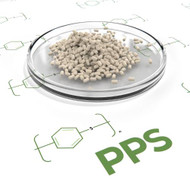PPS / Polyphenylene Sulfide: Dimensional Stability and Chemical Resistance
History
German chemist Hermann Staudinger discovered polyphenylene sulfide (PPS) in 1888 during his groundbreaking studies on macromolecules, which subsequently earned him the Nobel Prize in Chemistry. At the time, however, the polymer did not exhibit sufficient stability for industrial applications. PPS gained commercial significance 70 years later when Phillips Petroleum independently developed a refined process that enhanced the material’s stability, transforming it into the thermoplastic known today as “the polymer that doesn’t melt.” Recognizing the commercial potential of PPS as a high-performance thermoplastic, the company established an optimized synthesis route involving the reaction of sodium sulfide with 1,4-dichlorobenzene in N-methyl-morpholine (NMP). This organic polymer comprises aromatic rings linked by sulfide bridges.
Quick Highlights
- German chemist and Nobel Prize laureate Hermann Staudinger discovered polyphenylene sulfide in 1888, which reached the commercial market in the 1960s when Phillips Petroleum developed a process that enhanced the material’s stability.
- The polymer known today as “the polymer that doesn’t melt” is synthesized through the polymerization of sodium sulfide and 1,4-dichlorobenzene, yielding chains of aromatic rings linked by sulfide bridges.
Manufacturing Properties
PPS’s ability to withstand harsh conditions, including chemical and thermal attacks, has enabled its use in textiles, electrical insulation, specialty membranes, molding resins, and gaskets. It has even been employed in parts of Mars rovers. PPS is typically processed through molding or extrusion, but it can also be machined to tight tolerances. An alternative method gaining popularity is 3D printing, especially for low-volume, high-performance components. Similar to other materials, additives are widely used to fine-tune the properties of PPS-based products. These include reinforcements, such as glass fibers or carbon fibers, for increased strength, fillers for improved dimensional stability, lubricants or impact modifiers, flame retardants, and UV or thermal stabilizers. Nonetheless, PPS processing presents certain challenges, including the high processing temperatures that require specialized equipment, the brittleness of unmodified PPS, and its moisture sensitivity before processing.
Quick Highlights
- PPS can withstand extreme conditions, enabling its use in textiles, electrical insulation, specialty membranes, molding resins, gaskets, and even Mars rover components.
- It is typically processed through molding or extrusion, but it can also be machined to tight tolerances or used in 3D printing. Additives can be added during processing to fine-tune certain properties, such as reinforcements, fillers, lubricants, flame retardants, or UV stabilizers. Processing also presents challenges, requiring high temperatures and specialized equipment.
Tensile Strength
PPS exhibits excellent tensile strength and rigidity, even under mechanical stress, while reinforced grades containing glass or carbon fibers demonstrate enhanced toughness. The material has outstanding dimensional stability, maintaining its shape and mechanical integrity under prolonged mechanical loads. With its very low coefficient of thermal expansion, PPS preserves its dimensions under varying temperatures, making it suitable for bearings, gears, and structural components
Quick Highlights
- PPS exhibits high tensile strengths and rigidity with glass fiber or carbon fiber reinforced variants, demonstrating enhanced toughness.
- It has exceptional dimensional stability even under prolonged mechanical load and displays a very low coefficient of thermal expansion.

Chemical Properties
One of PPS’s main advantages is its exceptional chemical resistance. It is inert to most chemicals, including acids, bases, fuels, and organic solvents. Combined with its resistance to water, steam, and humid conditions, PPS performs well in harsh chemical environments such as those found in chemical processing equipment, fuel systems, and outdoor applications.
Quick Highlights
- PPS’s chemical resistance is a significant advantage. It is inert to most chemicals (acids, bases, fuels, organic solvents), resistant to water and steam, and performs well in harsh chemical environments.
Thermal Properties
PPS has a melting point of approximately 285 °C (545 °F) and can withstand prolonged exposure to temperatures between 200 and 220 °C (392 to 428 °F) without significant degradation. Moreover, it exhibits good thermal aging resistance, retaining its chemical and mechanical properties even after prolonged exposure to high temperatures. PPS is naturally flame-retardant, which is critical in aerospace, automotive, and electrical safety applications. Additionally, it emits low levels of toxic gases during combustion, meeting stringent safety standards across industries.
PPS boasts exceptional dielectric properties, maintaining its insulating ability even at high temperatures, enabling its use in electrical and electronic components. It also has a low dielectric constant, which minimizes signal loss in electronic devices—an essential characteristic for high-frequency applications.
Quick Highlights
- PPS has a melting point of 285 °C (545 °F) and can withstand prolonged exposure to temperatures between 200 and 220 °C (392 to 428 °F) without significant degradation. Moreover, it exhibits good thermal aging resistance, retaining its properties even after prolonged exposure to heat.
- It is naturally flame-retardant and emits low levels of toxic gases during combustion, meeting safety standards across industries.
- PPS has exceptional dielectric properties, maintaining its insulating capabilities even at high temperatures.
- Its low dielectric constant is particularly advantageous for minimizing signal loss in electronic devices.
UV Properties
PPS exhibits moderate tolerance to UV radiation, although prolonged exposure to high levels of UV light can lead to degradation. To address this limitation, UV stabilizers can be added during production. These stabilizers enhance UV resistance, enabling PPS’s use in outdoor applications. Its resistance to other environmental factors, including temperature fluctuations, moisture, and oxidation, further supports its suitability for outdoor use. PPS also demonstrates good resistance to X-rays and gamma radiation, making it an excellent choice for medical applications.
Quick Highlights
- PPS has moderate tolerance to UV radiation, but prolonged exposure may cause degradation. UV stabilizers can be added during processing to address this vulnerability. It also demonstrates g good resistance to X-rays and gamma radiation.
- It has good resistance to weather conditions, including varying temperatures, oxidation, and moisture.
Sustainability
While PPS is an important thermoplastic, its environmental impact is significant. It is a downstream product of the petrochemical industry and requires energy-intensive processes for production, both of which contribute to greenhouse gas emissions. Additionally, PPS is non-biodegradable, and its durability can lead to environmental persistence if improperly disposed of, posing waste management challenges. On the other hand, its long lifecycle reduces the need for frequent replacement, conserving resources over time. Despite ongoing efforts to develop recycling methods for PPS, such methods remain limited. Addressing these environmental challenges through improved energy and waste management, the development of recycling processes, and the pursuit of greener alternatives is crucial to reducing PPS’s environmental footprint.
Quick Highlights
- PPS has a significant environmental footprint due to its energy-intensive production, reliance on petrochemicals, non-biodegradability, and persistence in the environment, which poses waste management challenges.
- However, its long lifecycle reduces the need for frequent replacements and conserves resources, but improved recycling methods, energy management, and greener alternatives are essential for minimizing its environmental impact.
Discover the exceptional strength and heat resistance of PPS / Polyphenylene Sulfide within the Material - Nuts & Bolts category. Explore the innovative applications and unparalleled performance capabilities of this advanced polymer material, perfect for demanding industrial and engineering needs. Dive into a world of precision and reliability with PPS / Polyphenylene Sulfide.
PPS hex head bolts provide exceptional strength, heat resistance, and chemical stability. Ideal for high-performance, industrial, and demanding load applications.





